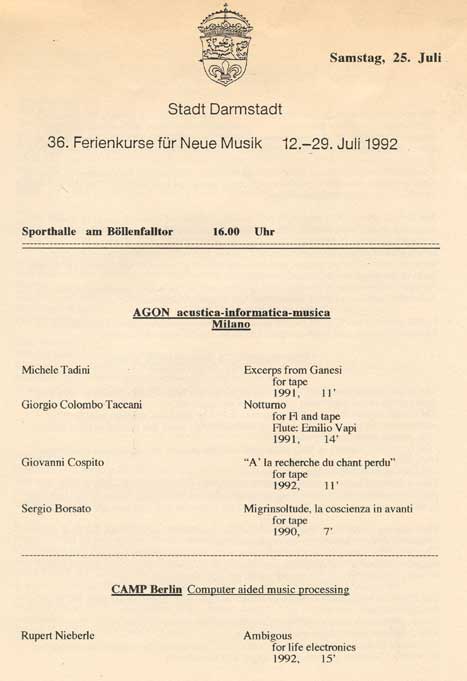NOTTURNO
per flauto in sol e elettronica / for alto flute, tape and live electronics
(1991/93)
dedicato a / dedicated to: Emilio Vapi - Italia
EDIZIONI SUVINI ZERBONI - MILANO
 audio - complete
audio - complete
Realizzato nel 1991 presso lo studio AGON di Milano, Notturno utilizza una parte estremamente definita e ristretta delle possibilità che le attuali tecniche di trattamento digitale del suono consentono al compositore; la parte su nastro è interamente basata su suoni di flauto in sol campionati e catalogati grazie alla collaborazione preziosa del flautista Emilio Vapi; tali suoni sono stati in seguito elaborati tramite computer, senza che tuttavia ne venisse snaturata completamente l'origine.
Notturno si presenta diviso chiaramente in tre parti: nella prima, della durata di quattro minuti e mezzo circa, predominano suoni rauchi e ricchi di soffio, in un clima di soprassalti improvvisi e di inquiete stasi; una seconda zona più breve (tre minuti circa) propone una sorta di sordo respiro attraverso il quale si fanno largo suoni che tendono sempre più all'emissione ordinaria del flauto, mentre l'andamento si fa via via più calmo; si giunge quindi all'ultima parte, della durata di cinque minuti circa, in cui la rarefatta parte del flauto dal vivo, ferma entro la prima quinta di estensione dello strumento, è circondata dagli echi della parte su nastro, che ne propone un lento canone, irriconoscibile sia per il notevole rallentamento metronomico sia per lo sprofondamento verso il registro grave di molti campioni impiegati. Un lungo sol grave del flauto e della parte su nastro chiude Notturno in un'atmosfera di attonita fissità.
Notturno was written in 1991 with the precious collaboration of flutist Emilio Vapi.
The tape is completely filled with alto flute sampless, which were made at the AGON studio in Milan; these samples have been elaborated by computer without hiding their instrumental provenence.
Notturno is clearly divided into three parts: the first of them (about five minutes long) is characterized by hoarse and breathy sounds, with unexpected bursts and an anxious stasis; flute and tape are often juxtaposed with violence, and there is no possible interaction between the two worlds.
The second part is shorter (about three minutes long) and shows a muffled breath, with the presence of sounds that become more and more similar to ordinary flute playing; several samples begin to transform themselves from breathy and noisy sounds to echoes and shadows of the live flute part.
After a final burst, the expressive climate calms.
A short connection leads to the last part of the piece (about five minutes long), where the rarefied part of the flute, that plays sounds of the first fifth of its range, is surrounded by taped echoes; it is a slow canon, that is hardly recognizable both for the considerable slowing down, and for the falling to the low register of many samples.
A long G with the alto flute and tape ends Notturno.




